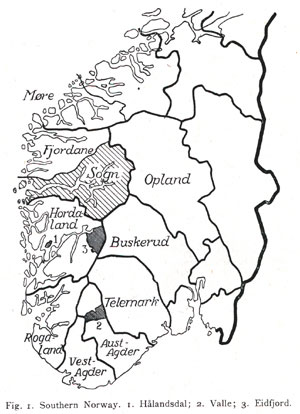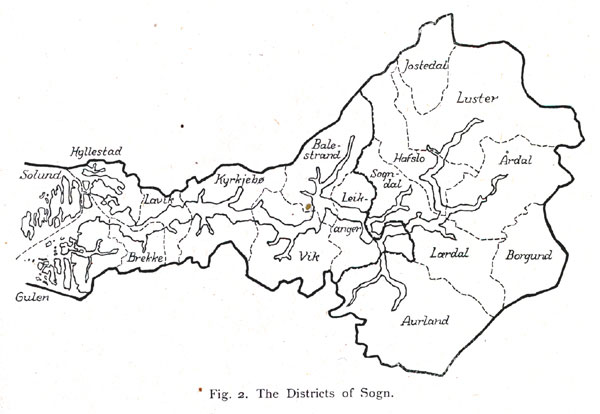|
|


|
The investigation of the skull material showed that the population in Sogndal in the first half of the last century - the period from which the material is derived - was highly mixed and included individuals with long as well as short, with broad as well as narrow, but mostly low heads, and that the various calvarial forms might be combined with very different facial forms. A considerable number of the skulls belong to the Nordic type, others with their greater breadth of both the calvaria and face were closer to the Alpine and East Baltic types, while the majority exhibited a combination of traits from these different types. Several skulls exhibited structural traits which were similar to Upper Palaeolithic forms. The investigation of the living population in Sogndal-Hafslo showed that the population of these districts at the present time, just as a hundred years ago, is highly mixed from a racial standpoint, and that there is a dominant Nordic element in the mixture in addition to a brachycephalic element according to the pigmentation. The mean cephalic index in this district is between 81 and 82, while the mean cranial index for men and women is 77.7. Such a considerable difference can hardly be interpreted otherwise than that the cephalic index has increased in the course of the last century. In none of the other districts investigated in Sogn is the pigmented brachycephalic type so prominent as in Sogndal-Hafslo, and nowhere is the head height so low as in Sogndal. A striking feature of the pigmentation is the redistribution of racial characters encountered in both Sogndal-Hafslo and in Brekke, expressed by the combination of pure blue eyes with dark brown hair. The population in Brekke has a higher mean stature than in Sogndal-Hafslo, the breadth and height of the head is greater but the length shorter. The cephalic index is therefore several units higher. The face is larger, both higher and broader, the same is true of the nose. The pigmentation of the eyes is lighter, light brown and greenish eyes occur less frequently and dark brown eyes as a rare exception. The population seems to have a stronger degree of East Baltic mixture than in Sogndal-Hafslo. The measurements from Lavik seem to indicate that this population is probably closest to the population in Brekke as regards physical traits. The limited material examined from Middle Sogn and the districts around the inner arms of the fjord shows that the population in these regions is of a more pronounced Nordic type than both in Sogndal-Hafslo and Brekke-Lavik. No definite conclusion as to the physical traits of the population around the mouth of the fjord can be drawn from the results obtained frorn the very limited material. The striking difference between the data collected here and the results from Brekke and Lavik may very well be due to chance in the composition of the small material, but at the same time calls for more extensive investigations. Judging by the geographic position of Sogn, it is obvious that its population has come partly across country from the eastern valleys of Valdres and Hallingdal, and partly by sea from the coastral districts to the north and south or directly over the ocean. The extent of the Nordic type around the inner arms of the fjord has its natural explanation in its land connections with the Eastern Norway. The similitary between the population in these districts and in Hallingdal and Valdres must also be apparent to any investigator. We must assume that Nordic peoples from the inner parts of Sogn have moved toward the west and settled in large areas of Middle Sogn, especially on the south side of the fjord, at the same time as these regions were also settled by considerable numbers of people from the western coastal districts. Long before this settlement took place, people from the south, chiefly from Jutland, perhaps also from the Baltic countries, had taken possession of the outer coastal districts of Sogn as well as other parts of Norway's southern and western coast. From investigations in Jaeren and in Sunnfjord which can be designated partly as Alpine, partly as East Baltic which borders Sogn in the north, we can conclude that the East Baltic type has been a predominant element among these peoples, and it is logical to assume that a number of the physical traits which characterize the present population of Brekke are a heritage from the population of this early period. The pronounced brachycephaly which distinguishes the population of Brekke today, and which is more pronounced than that found in the other coastal districts, e. g. Jaeren, may be due to inbreading in a reality isolated district, possibly also to mixture with people of Alpine type. But how shall we explain that in Sogndal-Hafslo, which lies like an island between the inner and middle regions of Sogn with their populations of predominantly Nordic type, we find a population whose physical traits exhibit more pronounced indications of Alpine mixture than any other part of Sogn? The answer to this can only be an assumption. When one travels in along the Sognefjord on a summer day and reaches Sogndal, one is captivated by the beautiful scenery, the open, fruitful fields around the protected shores without any threatening, overhanging mountains. It is obvious that this landscape must have seemed attractive to the wandering people who came sailing into the fjord to find a place to settle, and that this locality must have been settled very early, before the settlement from east, so that when the latter began on a larger scale, probably during the great migrations, the Sogndal district was already occupied. It is reasonable to assume that the settlement of Sogndal, by people of a predominantly Alpine type, was a branch of the settlement which took place in England and Scotland from the south in the beginning of the Bronze Age and which has left marked traces in other parts of the west coast of Norway. Through mixture with peoples of predomiriantly Nordic type who settled in the neighboring districts at a later date, and with peoples of predominantly East Baltic type who had settled in the outer coastal districts, the present population of Sogndal-Hafslo could have obtained its physical characteristics according to this assumption. In the discussion of the skulls from Sogndal it was mentioned that some of them exhibited traits which indicated a relationship to skull forms known from the Stone Age, and similarly the head form of several of the men from Sogndal whose photographs are reproduced on the plates was described as "Borreby-like" and "Upper Palaeolithic". How shall we explain the occurence of such characteristic points of similarity between individuals now living in Sogn and those who lived in southern Scandinavia during the Stone Age? In a previous publication (1941) the present author discussed the various combinations of Nordic and East Baltic racial characteristics which occur in the population of Rogaland, and how some of these type mixtures may be characterized as Cro-Magnon-like, while others show characteristic Borreby traits. The distribution of the latter in the population of Rogaland indicates, according to the interpretation set forth in this publication, a connection between Rogaland and South Scandinavia in the Neolithic period, a connection for which there is also other reliable evidence. The same explanation of the occurence of similar types in Sogn seemes to be logical. It is also possible that the populations both in Sogn and other parts of Western Norway retain, to varying degrees, a heritage from the oldest hunter and fisherfolk of the country who must be assumed to have belonged to the Cro-Magnon race. However it should be remembered that types like those mentioned above might also be the result of new combinations through mixtures of different racial types. As early as 1887 Arbo states that the population in Sogndal-Hafslo-Luster, in addition to its brachycephaly and darker pigmentation, is also distinguished by an "agilité physique et intellectuelle assez remarquable". It is obvious that long association with a population is necessary in order to pronounce a well-founded judgment on its intellectual characteristics. The present author lacks these qualifications, but even a brief contact with a group of people will afford a certain impression - even though superficial - to anyone who goes from house to house and speaks with people of various ages and occupations. The impression which I have gained in Sogndal is the same as Arbo's, but does not differ from that which I carry away from Brekke. The understanding which I met in both these districts for the questions which were necessary in my work and which faciliated my investigations to a high degree, will always be gratefully remembered. |